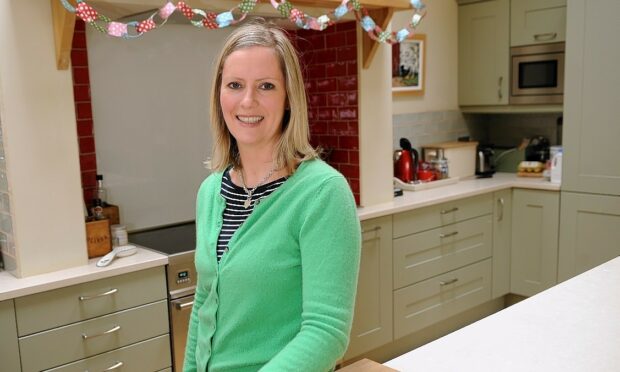Nick has been in dairying for 15 years, more if you factor in school and university holidays working for his dad at the original home farm near Inverness.
He may not have taken the plunge with hi-tech robots to help with the year round twice daily milking, but he is constantly striving to improve efficiencies here at Rootfield – ways to save money, improving cow accommodation and diet, and thus improving health, fertility and productivity.
To this end, Nick engaged the services of specialist consultants Promar at the beginning of the year to conduct an ongoing farm efficiency audit.
Alasdair, from Promar, comes to the farm one day a month and while some of the time is spent in the sheds, parlour and out in the fields, the rest is done indoors on computers and in conversation.
What became clear early on was that Nick needed an office outwith the family home. Our living space is open plan and while Nick and Alasdair happily got on with business at the kitchen table during nursery hours, the minute Daisy came home interruptions were rife.
Despite my best efforts to distract her with toys and games in the living-room, the temptation of daddy at home during the day proved too much for our inquisitive four-year-old. I could take her out for the afternoon, but we still needed lunch first – not a quiet affair, as you can imagine.
Nick quickly ordered a two-room timber cabin – the larger-windowed room would be his office, the second narrow space would be for a future ice-cream honesty shop.
Currently, the ice-cream production and parlour is based 15 miles from the farm at an established hospitality and retail development just south of Inverness, a decision originally made in part due to the guaranteed footfall for ice-cream sales but primarily due to a lack of space at Rootfield.
The first reason still holds true as sales continue to increase at the ice-cream parlour year on year, but thanks to Nick and Alasdair’s ongoing efficiency drive, some space has been freed up on the farm which would work well for milk processing and production.
Situated next to the milking parlour and milk tank, a cluster of original farm buildings has been earmarked for converting. For over a decade, this space has been calf accommodation but it has always been draughty and difficult to clean, living conditions which clearly do not contribute to optimum calf health.
Nick has already had a provisional green light from environmental health to convert the space and has met with engineers to discuss the feasibility of a pipe feeding directly from the milk tank to the production kitchen.
So far everything looks good, on paper anyway.
The time Nick would save on delivering the raw milk to the current production kitchen, which at this time of year can be every day, is significant. The 30-mile round trip takes an hour, which when multiplied by an average of four days a week, 44 weeks a year, accounts for 176 hours of Nick’s time.
That’s a whopping 14 extra working days (based on his standard 12-hour day) a year he’d get back. Not to mention the savings he would make on fuel and vehicle deterioration costs.
We have no plans to move the ice-cream counter to the farm, it will simply become another outlet that we supply, like our other trade accounts. But by moving production and processing on-farm, we will be able to concentrate on maximising efficiency of the ice-cream business as a whole as well as expanding our product range.
All these plans, however, won’t come into play until well after the busy summer season. Apart from a small peak in demand in the run-up to Christmas, from November until early March things are very quiet on the ice-cream front. And although it’s nice to catch our breath after a busy summer, we need to increase our product range to create a viable year-round business.
We can’t afford to retain full and part-time staff over the winter months when there’s not a lot of trade, but at the same time we can’t afford to lose them as not only are they conscientious and loyal, we have invested time and money in their training.
Earlier this month, for example, Nick and Rosie, who manages ice-cream production and the parlour, went to the West Highland Dairy, at Kyle of Lochalsh to learn how to make yoghurt and butter.
Established in 1987, West Highland Dairy runs regular dairy-making courses for anyone from keen amateurs to smallholders and commercial businesses. And being just over an hour’s drive from here, we’re extremely lucky to have this facility on our doorstep – Nick had to travel to Hereford for his initial ice-cream training, not an easy place to get to from the north of Scotland.
Run by co-founder of West Highland Dairy, specialist cheese-maker Kathy Biss, the day-long course provided a fantastic step by step, hands-on tutorial in producing butter and yoghurt from raw milk.
Nick came back enthusiastic and inspired with a fine pat of golden salted butter and two tubs of thick creamy natural yoghurt. While the butter was beautifully rich and flavourful, he agreed with his chief tasters and natural yoghurt aficionados, Daisy and I, that the prototype yoghurt needed a little work, something that can be done by adding different cultures.
Just like the all important “base mix” ice-cream recipe at the beginning, the yoghurt will go through a number of versions before it goes to market. We want to create as traditional and pure a product as possible, but it has to taste great too.
At least this time we won’t have to restrict Daisy’s (or our own) testing of the yoghurt like we did for the ice-cream.
* Rootfield Farm is on the Black Isle, 10 miles north of Inverness, where Jo lives with husband Nick, a fourth-generation dairy farmer, their daughter Daisy and 150 cows
